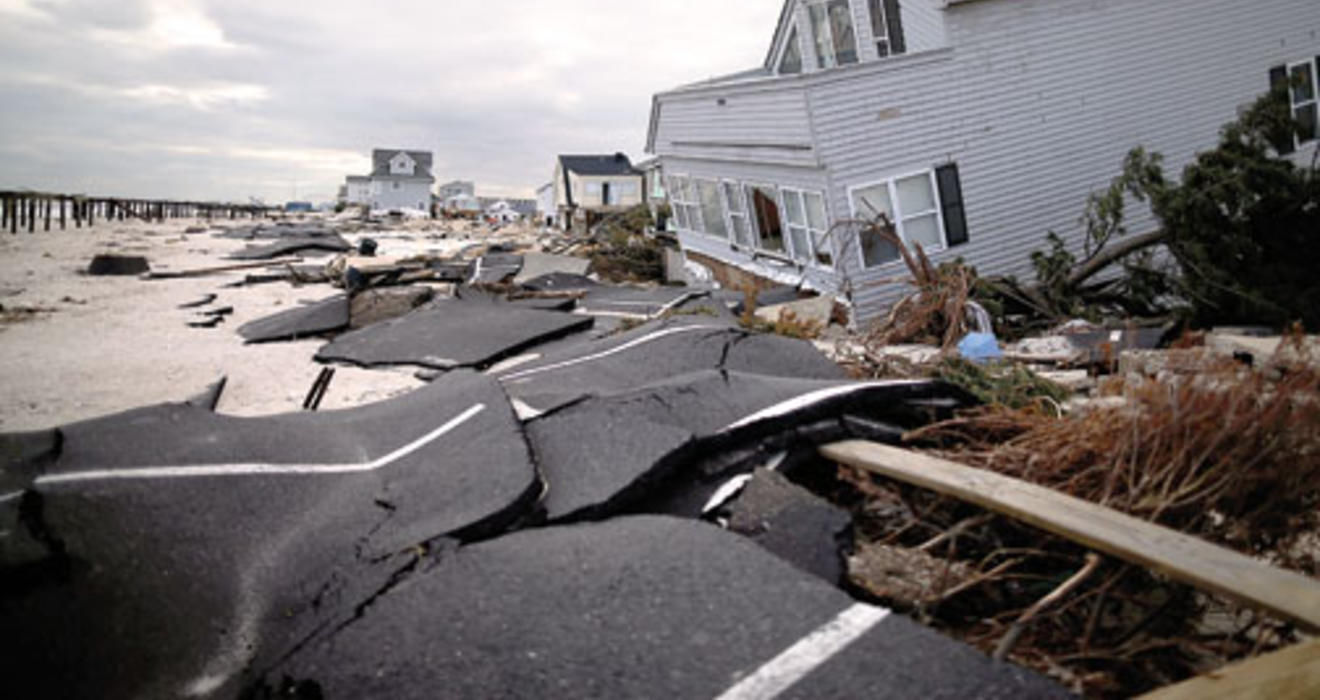
Along New Jersey’s Route 37, the traffic begins to thin out and the police checkpoints become more frequent as you approach the bridge linking the mainland to the beachfront communities on the Barnegat peninsula. Only local residents, government officials, contractors, and cleanup crews are allowed to venture near the shore.
It is Thanksgiving weekend, about four weeks after Hurricane Sandy struck the New Jersey and New York coastline, and few residents have returned to Ortley Beach, one of the hardest-hit communities in New Jersey. According to The New York Times, about 10 percent of the 2,000-plus houses were destroyed, and almost all were damaged.
“See that house over there that smashed into the other house? Here is its foundation,” says Ning Lin *10, pointing to a massive hole in the ground that is lined with concrete blocks. She wears a hardhat and neon-colored vest, and stops to snap photos of the damage. Lin, a Princeton assistant professor of civil and environmental engineering, is part of a research team led by Professor Andrew Kennedy of the University of Notre Dame. The researchers have come to Ortley Beach to survey the wind and water damage to homes there and in nearby Seaside Heights.
Devastation awaits them. The famous boardwalk is gone, pieces strewn in every direction. Some buildings have slid 30 feet inland, their foundations left behind. Chunks of black asphalt from a parking lot lie wherever the water and wind left them. They probably came from Joey Harrison’s Surf Club, on the waterfront. The club is standing but severely damaged. A scoreboard hangs on its side. “Surf Club versus Sandy,” someone has written in black marker, with a score underneath: 0 to 1, the storm victorious.
Princeton professors have been studying extreme weather, natural disasters, and their impact on people and property for years, but Hurricane Sandy pushed their research to the forefront. No longer was their work theoretical: It now is discussed in front-page newspaper stories and in government offices, particularly in and around New York City.
In addition to Lin, an expert on coastal engineering and the impacts of extreme weather, the professors include Guy Nordenson, a structural engineer who is deeply involved with post-Sandy planning in New York City; climate-change expert Michael Oppenheimer, whose work informs planners around the world; and Erik Vanmarcke, who for years has been a consultant to the flood-prone Netherlands. They and several alumni are working to develop tangible strategies to deal with the effects of global warming. Although a direct line cannot be drawn from climate change to Sandy, says Oppenheimer, the director of Princeton’s Program in Science, Technology and Environmental Policy, it is clear that sea levels are rising because of climate change: “There is no doubt about it. That is a one-to-one link.”
In Ortley Beach, the researchers are cataloging the extent of wind and wave damage to 375 houses on several blocks closest to the ocean — checking the damage at each home and determining whether it was caused by wind, windborne debris, or the storm surge. They will identify trends: whether elevation was enough to prevent major damage, what type of building foundations sustained the most damage, and what kinds of building materials were most likely to result in windborne debris that caused damage to adjacent houses. It’s a slow process, but they hope this information can be translated into ways to prevent or minimize damage to residences during future storms — proposals for different building practices and materials, for example. Lin points to a lone house standing a block south of the waterfront. “A combination of construction and location matters,” she says. “Some buildings are better built, with stronger foundations, but were totally destroyed. We want to know why.”
Recently, Lin has been working on mathematical risk assessments of the types of hurricanes we can expect in the next several hundred years. Her model simulates many storms — of different intensities and sizes — under a range of climate conditions, and predicts how likely they are to occur.
The findings by Lin and her Princeton colleagues are sobering. In 2010, the researchers — Lin, atmospheric-science professor Kerry Emanuel, and civil and environmental engineering professors Vanmarcke and James Smith — found that storms making landfall on the New Jersey coast would push water into the angle formed by the New Jersey shore and Long Island. This water has nowhere to go but into Lower Manhattan, where it would cause flooding. Then, in a study published in the journal Nature Climate Change in February 2012, they concluded that warmer temperatures and a 1-meter rise in sea level (predicted to occur sometime within the next 100 years or so) increase the probability of hurricane-related storms and higher storm surges in New York City.
How often might such dangerous storms occur? The term “100-year storm” doesn’t mean, as many people believe it does, that such a storm will occur only once in a century. Rather, it describes probability: Such a storm has a 1 percent chance of occurring in any given year. Hurricane Irene was considered a 100-year storm, for example, and yet Sandy struck a year later.
“[We] found that what we used to think of as a 100-year storm, now, under climate-change conditions, may be more like a 20-year storm,” says Vanmarcke, meaning there is a 5 percent probability of it occurring in a given year. “The recurrence is faster, the risk is higher, and the likelihood of storms in any one year may have increased as much as five-fold,” he says. What has been seen as a 500-year storm likely would occur once every 25 to 240 years by the end of this century, the study found.
The researchers are continuing to model hurricanes, incorporating data on recent hurricanes in Florida, Louisiana, and North Carolina. A detailed database that includes wind-speed patterns, and information on wind pressure and the breadth of the winds, is being collected nationally. The worst-case storms Lin is modeling have a storm surge of more than 4.5 meters, or 14.8 feet, at high tide.
Vanmarcke points out that the damage caused by Sandy — the largest storm recorded in the Atlantic Ocean — “really highlights the vulnerability” of New York City. Sandy, which combined high wind speed with very low pressure when it merged with a weather system from the west, was barely a category-1 hurricane, and yet the storm surge was strong: about 2.8 meters, or 9.2 feet, in New York City. The water level observed at the Battery, the southern tip of Manhattan facing New York Harbor, was almost a meter higher than the previous record, set by a hurricane in 1960.
With results like that, Sandy became the wake-up call that accelerated the move of the researchers’ ideas out of academic journals and into government offices. Vanmarcke says it usually takes a major event to spur politicians and the general population to enact policies that could lessen the effects of future natural disasters. Seismic codes in California have been strengthened after major earthquakes; major hurricane damage prompted construction-practice overhauls in Florida. Vanmarcke advises the government of the Netherlands on its risk and exposure to high waves, and notes that it was after a North Sea storm in 1953 took more than 1,800 lives that the Dutch were “willing to spend a lot of money to reduce their exposure to risk,” investing $13 billion on a 40-year construction effort to install a wall along the North Sea and construct dike systems. More recently, the nation approved spending up to 10 billion euros per year for the next decade to upgrade its defenses against flooding.
Now, Princeton researchers are helping policymakers decide what to do around New York. Vanmarcke, Oppenheimer, Lin, and Nordenson are on a New York City advisory panel on climate change. Nordenson, an architecture professor and structural engineer, is well-acquainted with the effects of natural disasters, and not just with storms: An expert in earthquake engineering, he led the development of New York City’s seismic code in the 1980s and 1990s. Today he serves as a member of the New York City Public Design Commission, which must approve all permanent architecture and landscape projects on city property. One of the commission’s tasks is to advise on reopening the beaches this summer.
Some of the ideas that Princeton architects and engineers have been studying for years now are being tested in New York City, including bioswales (vegetation planted curbside that acts as a filter for water runoff), porous sidewalks that act as sponges, and wetland reclamation. Many of these proposals were developed in a project, published in 2010 as a book called On the Water | Palisade Bay, which explored the effects of climate change and came up with a plan to respond to rising sea levels in New York City. Shortly afterward, the idea behind Palisade Bay was broadened when the Museum of Modern Art mounted its “Rising Currents” exhibition, choosing five New York-based architectural firms to redesign different sections of the waterfront in ways that fit with its ecology.
While the idea of manmade storm barriers, such as sea walls, has been proposed for the New York City area, the Princeton participants in “Palisade Bay” and “Rising Currents” preferred a different approach. Their main idea — which can be a template for other coastal communities — is that using natural, adaptive systems along the waterfront can create a more resilient coastal environment, explains Catherine Seavitt *96, an associate professor of landscape architecture at City College of New York, who led the “Palisade Bay” project along with Nordenson. “Our understanding of water and land has been such a fixed notion — one side is wet and one is dry — but you have to think about it as a sloped line and the surface as a gradient,” she says. Creating wetlands, for example, could limit damage: Though flooding still would occur, water would enter and retreat through the wetlands. Building sidewalks out of porous materials, including permeable concrete, is another strategy, based on the same idea.
As a “Rising Currents” team, Nordenson, Seavitt, and Adam Yarinsky *87, a principal at Architecture Research Office in New York City, redesigned infrastructures for the Lower Manhattan coastline, adding water slips and swapping out traditional, flat piers for sloping piers with water channels. The team also proposed re-introducing oyster reefs and creating wetland and archipelago islands in the Upper New York Bay. They envisioned Lower Manhattan and the Upper Bay as having not fixed land and water boundaries, but a “soft infrastructure” of natural systems. Implementing the improvements would cost between $5 billion and $8 billion, Nordenson says.
Though it’s a sensitive issue, policymakers also have been discussing whether some or all of the areas destroyed by Sandy should be rebuilt at all. In February, New York Gov. Andrew M. Cuomo proposed to spend up to $400 million to buy and demolish homes that had been destroyed by Sandy, turning the land into public parkland and dunes, wetlands, and other natural buffers that could protect coastal communities. The idea for the voluntary program emerged from a state commission created after Sandy to help New York withstand natural disasters. Nordenson serves on that group, too. Cuomo’s plan “is the right balance of respect for property rights and incentives to get the right outcome” of less risk, he says, noting that some residents already have expressed a willingness to sell their property.
Paul Lewis *92, an associate professor of architecture at Princeton who led another “Rising Currents” team, is working to help the city reopen its beaches by Memorial Day, and is redesigning the iconic Coney Island pier. The short-term task, says Lewis, is making sure the beaches are safe and accessible, and reconstituting portions of the boardwalk.
Whether the entire boardwalk should be rebuilt in places where it was severely damaged or wrecked still was being debated in February. Rebuilding would provide hard-hit communities with a sense of normalcy, but Lewis suggests they might be better off with sand dunes, a natural barrier that would make the beaches more resilient. One option being considered by the city is embedding the Coney Island boardwalk’s concrete pilings into the dunes as anchors. This might lessen storm damage while still allowing people to enjoy the familiar setting.
Ultimately, though, the largest obstacles in the way of better storm protection may be political, not technical. A consensus has developed about environmental approaches — policymakers can look to cities like London, Rotterdam, and Tokyo that have built sea walls, developed wetlands, and taken other steps to minimize damage.
But while Lewis has been impressed by the “unprecedented” cooperation and speed with which New York City agencies have worked to rebuild the shoreline to allow public access, he knows that both hearts and minds still must be won. He was surprised when he saw city planners’ maps of New York Harbor showing flooding from Sandy — because the New Jersey portions were left blank. (In their own planning, the architects and engineers discarded political boundaries and concentrated on geographic boundaries — just as nature does.) And despite the protection dunes might offer, many homeowners prefer their beaches wide and flat, without dunes blocking the view. In Ortley Beach, for example, some beachfront residents have been reluctant to grant easements that would jumpstart a public project to build dunes and elevate the privately owned beach.
Yarinsky is optimistic that New Yorkers, at least, would find the will, recalling the city’s history of major public infrastructure projects: “New York City’s excellent water-supply system is over 100 years old, and Central Park is an example of a civic investment built with great foresight,” he says. “So we can do it.”
Anna Azvolinsky *09 is a freelance writer specializing in science.







No responses yet